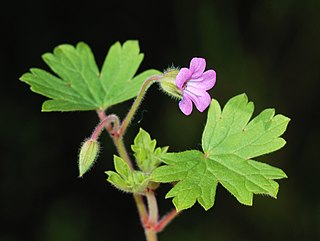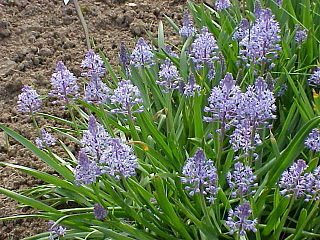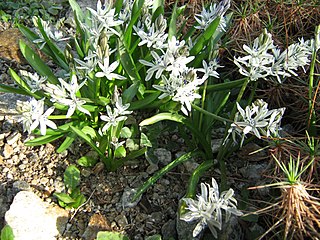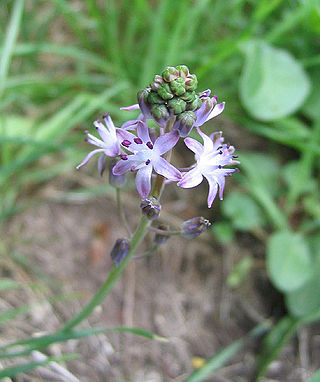
Geraniaceae is a family of flowering plants placed in the order Geraniales. The family name is derived from the genus Geranium. The family includes both the genus Geranium and the garden plants called geraniums, which modern botany classifies as genus Pelargonium, along with other related genera.

Brodiaea, also known by the common name cluster-lilies, is a monocot genus of flowering plants.

Scilla is a genus of about 30 to 80 species of bulb-forming perennial herbaceous plants in the family Asparagaceae, subfamily Scilloideae. Sometimes called the squills in English, they are native to woodlands, subalpine meadows, and seashores throughout Europe, Africa and the Middle East. A few species are also naturalized in Australasia and North America. Their flowers are usually blue, but white, pink, and purple types are known; most flower in early spring, but a few are autumn-flowering. Several Scilla species are valued as ornamental garden plants.

Leucojum is a small genus of bulbous plants native to Eurasia belonging to the amaryllis family, subfamily Amaryllidoideae. As currently circumscribed, the genus includes only two known species, most former species having been moved into the genus Acis. Both genera are known as snowflakes.

Scilloideae is a subfamily of bulbous plants within the family Asparagaceae. Scilloideae is sometimes treated as a separate family Hyacinthaceae, named after the genus Hyacinthus. Scilloideae or Hyacinthaceae include many familiar garden plants such as Hyacinthus (hyacinths), Hyacinthoides (bluebells), Muscari and Scilla and Puschkinia. Some are important as cut flowers.

Ornithogalum is a genus of perennial plants mostly native to southern Europe and southern Africa belonging to the family Asparagaceae. Some species are native to other areas such as the Caucasus. Some species are classified as noxious invasive weeds in some portions of North America. Growing from a bulb, species have linear basal leaves and a slender stalk, up to 30 cm tall, bearing clusters of typically white star-shaped flowers, often striped with green. The common name of the genus, star-of-Bethlehem, is based on its star-shaped flowers, after the Star of Bethlehem that appears in the biblical account of the birth of Jesus. The number of species has varied considerably, depending on authority, from 50 to 300.

Hyacinthoides is a genus of flowering plants in the family Asparagaceae, known as bluebells.
Botanical nomenclature is the formal, scientific naming of plants. It is related to, but distinct from taxonomy. Plant taxonomy is concerned with grouping and classifying plants; botanical nomenclature then provides names for the results of this process. The starting point for modern botanical nomenclature is Linnaeus' Species Plantarum of 1753. Botanical nomenclature is governed by the International Code of Nomenclature for algae, fungi, and plants (ICN), which replaces the International Code of Botanical Nomenclature (ICBN). Fossil plants are also covered by the code of nomenclature.

Scilla luciliae is a species of flowering plant in the family Asparagaceae. It is referred to by the common names Bossier's glory-of-the-snow or Lucile's glory-of-the-snow, and is a bulbous perennial from western Turkey that flowers in early spring. After flowering, it goes into dormancy until the next spring. The specific epithet is in honour of Lucile, the wife of the Swiss botanist Pierre Edmond Boissier (1810-1885). It belongs to a group of Scilla species that were formerly put in a separate genus, Chionodoxa, and may now be treated as Scilla sect. Chionodoxa.

Scilla litardierei, the amethyst meadow squill or Dalmatian scilla, is a species of flowering plant in the family Asparagaceae. A bulbous perennial, with blue grape-hyacinth like flowers, blooming in late spring, much later than the more popular Siberian squill and later than Muscari which it resembles.

Hyacinthella is a genus of bulbous flowering plants in the family Asparagaceae, subfamily Scilloideae. It is native to eastern and south-eastern Europe through to northern Iran, reaching as far south as Palestine. Turkey is the main country in which species are found.

Barnardia is a small genus of bulbous flowering plants in the family Asparagaceae, subfamily Scilloideae. The genus has two species, one found in the Balearic Islands and north-west Africa, the other in east China, Korea, Japan and adjacent localities. It was suggested in 2012 that the two species were not closely related.

Daubenya is a genus of bulbous flowering plants in the family Asparagaceae, subfamily Scilloideae. It is native to the Cape Province of South Africa. At first believed to consist of a single species, Daubenya aurea, the genus was expanded in 2000 to include the genera Androsiphonand Amphisiphon and various species that had previously been classified as Polyxena, Massonia, or Neobakeria. "The poor congruence between morphological and other characters within Hyacinthaceae has also made generic circumscriptions very difficult. One of the consequences of this has been the recognition of a large number of genera that are poorly defined morphologically."-

Dipcadi is a genus of bulbous flowering plants in the family Asparagaceae, subfamily Scilloideae. It is widely distributed, occurring in southern Europe, most of Africa and the Middle East through to the Indian subcontinent.

Fessia is a genus of bulbous flowering plants in the family Asparagaceae, subfamily Scilloideae. It is distributed from Iran to Central Asia and Pakistan.

Merwilla is a genus of bulbous flowering plants in the family Asparagaceae, subfamily Scilloideae. It is distributed in southern Africa, from Zimbabwe to South Africa. This genus is named after the botanist Frederick Ziervogel Van der Merwe (1894–1968), who worked on this group.

Prospero is a genus of bulbous flowering plants in the family Asparagaceae, subfamily Scilloideae. It is distributed in Europe, around the Mediterranean, and through the Middle East to the Caucasus.

Pseudoprospero is a genus of bulbous flowering plants in the family Asparagaceae, subfamily Scilloideae. The genus has a single species Pseudoprospero firmifolium, which is endemic to South Africa.

Marie de Brimeu, was a Flemish noblewoman known for her knowledge of botany and horticulture. She inherited her titles from her uncle, Charles de Brimeu, Count of Meghem, when he died in 1572, becoming the Countess of Meghem. Her second marriage in 1580 to Charles III, Prince of Chimay, elevated her to the rank of princess.

Brimeura amethystina, the amethyst hyacinth, is a flowering plant of the asparagus family Asparagaceae, native to the Northern Pyrenees and north east Spain. The record from the Kapela mountain (Croatia) by Reichenbach (1830) is probably a confusion with some Hyacinthella taxon growing in the Balkan area.



















